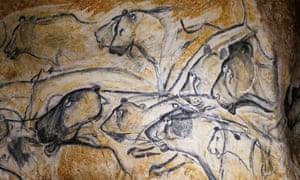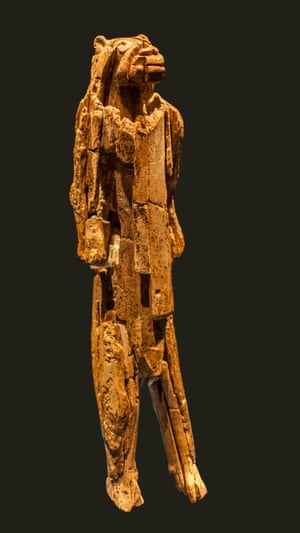On 24 January 1894, gold prospectors were digging in the Shigir peat bog, north of the town of Yekaterinburg in the Ural mountains, when they uncovered a strange collection of carved pieces of wood.
A total of 10 fragments were found beside each other. When put together, a wooden idol more than five metres high was created, one that had clearly been carved from a single, carefully smoothed plank of larch wood. Its surface was covered with zigzag lines and human faces and hands.
This is the Shigir Idol, and according to scientists writing in Antiquity, recent studies of its structure and its date of construction dramatically overturn our ideas about the appearance of art among humans. The idol, it transpires, is one of the oldest pieces of monumental art ever uncovered.
“Our analysis indicates that the Shigir Idol is around 11,500 years old,” said archaeologist Professor Thomas Terberger, of Göttingen University, in Germany, one of the authors of the Antiquity paper. “At that time, Europe and Asia were still emerging from the ice age. There were no farmers then. The only humans in this part of the world at this time were hunter-gatherers. Yet they created the Shigir Idol. The discovery of its antiquity therefore changes, dramatically, – our views about the birth of ritual art.”
Many examples of early stone age are known: they include the cave paintings of France and Spain, created more than 30,000 years ago, and tiny objects, carved out of mammoth tusks, that depict animals or animal-human hybrids. Many of these are extremely delicate and extraordinarily well crafted. But they are generally realistic in style. The symbol-covered Shigir Idol represents a leap beyond this sort of naturalistic art.
When the idol was discovered, the date of its construction was a matter of conjecture and remained so for a century until, in the 1990s, scientists removed a portion and used radiocarbon detectors to date it. It produced an age of about 9,800 years. any scholars rejected the result as implausible. Hunter-gatherers did not have the ability to make such a huge work or have the complex symbolic imagination to decorate it in the way that the idol has been adorned, sceptics argued.

As a result, a new, more sophisticated dating was sought and the result of that work is outlined in Antiquity. These show that far from being a younger object than was suspected by the sceptics, the idol turns out to be even older than was indicated by the first dating attempt. “The result was quite a surprise, I admit,” said Terberger.
In the past, large-scale complex art was considered to be the handiwork of later, sedentary farming people who started to spread from the Middle East about 8,000 years ago and took over land previously used by hunter-gatherers. These agrarian societies achieved considerable sophistication and were eventually responsible, in Britain, for the construction of great Neolithic works such as Stonehenge and the Ness of Brodgar in Orkney.
By contrast, it was assumed hunter-gatherers were not capable of the type of symbolic thinking, nor the organisation, that underpinned the design of these great monuments. However, the dating of the Shigir Idol suggests this is not the case and that the period just after the last ice age was not a cultural desert as some experts have argued. The lack of remains of hunter-gatherer monumental art may simply be blamed on the fact that they used wood which has not survived – unlike the stone works of their farming folk successors. Only the freak conditions of the peat bog of Yekaterinburg permitted the idol’s survival.
“We have to accept that hunter-gatherers had complex rituals and were capable of very sophisticated expression of ideas and art,” said Terberger. “These things didn’t start with farmers, they began with hunter-gatherers much earlier.”

Analysis of wood from the idol has also revealed much about living conditions. “If you study the rings, you can see trees were growing very slowly as it was still pretty cold then. Europe was still emerging from the last ice age. You can see that in the rings of the wood that makes up the idol.”
Over the years, archaeologists have dug up many small tools also decorated with zig-zag symbols in northern Europe, suggesting that society was much less fragmented than previously thought and that there was considerable sharing of ideas. Terberger said: “It is exciting to see these connections being established over huge distances.”
But what was the purpose of a monument that would have loomed over any terrain in which it was erected? “From our current perspective, it is very hard to work out what was going on in the minds of the creators of the Shigir Idol,” Terberger said. “However, I am struck by the similarity of the idol with the totem poles of native Americans in the north-west Pacific region.” Such poles often honour gods or ancestors and this could explain the purpose of the idol.
Other researchers suggest alternative theories. Mikhail Zhilin of the Russian Academy of Sciences – another of the paper’s authors – argues that the idol might depict forest sprites or demons while Vang Petersen, of the National Museum of Denmark, suggests that the carvings were “keep out” warnings not to stray on sacred land. “It’s intriguing,” Terberger says. “What is certain is that its makers were saying a lot more than just an announcement that ‘I can build a big pole.’”